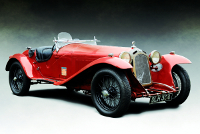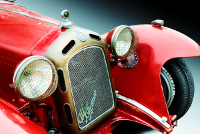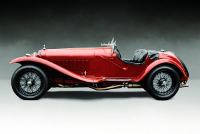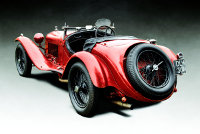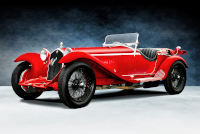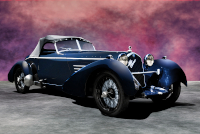Location:
Radnor Hunt Concours d'Elegance, 2010
Owner: Simeone Foundation Automotive Museum | Philadelphia, Pennsylvania
Prologue:
Another of the Simeone Foundation 8C Alfa Romeo cars, chassis #2211072 is a true period hot rod. As Alfa Romeo stories go, the tale of this car is exciting, from a Brooklands speed rally to the collection of animation illustrator Charles Addams. In this context, the car's hammered-together look makes perfect sense.
I've always been fond of this set—the only four photos I shot, but four confident shots. Sometimes the challenge of polishing digital illustrations is preserving the patina. But here the patina holds true, and the car looks in picture the way it looked in reality on that drizzly afternoon. Everything seems to work without much effort, which isn't often the case. This car certainly deserves more than four images, but then one can't replicate the atmosphere of an unseasonably cool Sunday in early September, much less turn the clock back a decade for one more perspective on some rough-hammered coachwork.
- - - - - - - - - -
► Image Source: Nikon D200 (10.2 MP)
References:
- Simeone Foundation Automotive Museum: The museum website provides a nice history of #2211072 and its previous owners.
- VeloceToday: "Reflections on the Alfa 8C 2300 Castagna" by Pete Vack, May 12, 2010. A nice commentary on #2211072, with lots of colorful anecdotes.
- VeloceToday: "VeloceToday Drives the 8C 2300 Alfa Mille Miglia Castagna" by Pete Vack, May 12, 2010. A companion piece to the article above offers driving notes on chassis #2211072.
- TravelingWithTools: Mechanic Greg Stasko illustrates the nuances of Vittorio Jano's 8C motor in a way we simply cannot do from the outside.
A car modified in 1933 shortly after its creation in 1933, the Simeone Founation references this unique Mille Miglia passo corto in the 1939 Brooklands fastest sports car contest. Driven by owner Guy Templar, the car achieves an average speed of 116 mph around the banked track, speeds 135 mph down Railway Straight, and logs a 0-60 time of 6.5 seconds. But for mechanical failure that prevents the car from completing the contest, chassis #2211072 lands among the top runners. The event returns no definitive result in terms of identifying the fastest car of the day, though a Delahaye wins the contest by virtue of attrition. The trial splits between a circuit and a mountain sprint, and most of the field falls aside with trouble.
The figures quoted sound particular to this car, though the account somewhat overlaps Simon Moore's reference to Hugh Hunter's entry with #412031, the Mille Miglia Touring Spider. Disambiguation to follow.
Chassis #2211072 comes to the United States in the post-War era and soon enters into the custody of Charles Addams, creator and artist behind The Addams Family. A member of the Sports Car Club of America, Charles owns a trifecta of prime classic era sporting machinery—this Alfa for one, a Bugatti Type 35C, and a Mercedes Type S. VeloceToday reports he also has a penchant for painting his cars black, but spares the Alfa from this macabre fate.
Notably, most Mille Miglia spiders receive coachwork by either Carrozzeria Touring or Zagato. Castagna is a rare choice for the bodywork of this short-chassis car, and #2211072 must be one of the few race-ready cars ever bodied by the Milanese company, let alone the only Alfa Romeo of its kind. In turn, the design cues of this particular car are somewhat special for Castagna.
While it is often difficult to prove originality, the Simeone Foundation Automotive Museum believes #2211072 to be largely original. The car has perhaps not been repainted since construction. Its motor was rebuilt once in the United Kingdom, but otherwise #2211072 remains unrestored.
Motor: 2,336 cc bored out to 2.6 litres, straight 8-cylinder, alloy block, aluminum hemi-head | 68 mm x 88 mm | 6.5:1 compression | motor #2211072
Vittorio Jano's race-prepared 8C motor uses a magnesium crankcase with aluminum main caps. On the case sit two aluminum cylinder blocks with iron liners, topped by a separate cylinder head formed in two 4-cylinder sections. Prepared for Brooklands, motor #2211072 would resemble an 8C 2600 Monza, whose internal dimensions and compression we represent above.
Valvetrain: DOHC, 2 valves per cylinder, modified Monza-spec cam, gear-driven via a central mechanism
The center of the crankshaft uses a sprung gear hub to control tolerance between both halves. Each camshaft is two pieces joined at the cam gear in the middle.
Aspiration: Memini S152 carburetor, Monza-spec Roots-type supercharger
Power: 165 bhp at 5,000 rpm
Drivetrain: 4-speed gearbox, rear-wheel drive
Front Suspension: beam axle, semi-elliptic leaf springs, friction dampers
Rear Suspension: live axle, semi-elliptic leaf springs, friction dampers
Architecture: pressed steel chassis with aluminum coachwork by Castagna of Milan
Kerb Weight: 1,000 kg (2,205 lbs)
Wheelbase: 2,750 mm (108.3 inches)
0-60: about 6.5 seconds
Top Speed: 217 km/h (135 mph)
Etymology:
'8C 2300' refers to the motor configuration, a straight 8-cylinder of about 2.3 litres displacement. The term 'spider' descends from the carriage trade, which in motorcar parlance came to refer to open sports cars. 'Castagna' calls out the Milanese coachbuilder responsible for the bodywork.
Figures:
Various reports cite that Alfa Romeo built anywhere between 188 and 195 8C 2300 cars; these comprised all manner of racing device—short and long chassis, Monza included—many of which targeted specific international events. Alfa built the cars in three series, with an additional group provided specially for Scuderia Ferrari. Of all those produced, Castagna bodied few cars, and of those, hardly any were racing spiders. This particular example is perhaps unique in its configuration, to say nothing of its own little peculiarities.
Castagna Style: The Rare Castagna Race Car
The Castagna take on a short-chassis Alfa Romeo identifies itself perhaps only in the odd crease that moves diagonally across the bonnet and drops along the doors into a small embossed circle. Apart from being a rather peculiar element to begin with, the placement of this circle is itself odd. Perhaps the panelcrafters had not factored the leather hides that cover the door sills, because the overlap nearly touches the edge of the circle, making the circle look a bit out of place. Similarly peculiar, the dumb irons out front are topped with heavy chrome accents, each pinned by two large screwcaps. Why Castagna chose such large accents—where Zagato or Touring would use lithe speed strakes—to say nothing of the choice of ornamenting the tops of the dumb irons, could underline the infrequency with which Castagna approached racing cars.
Factory Additives: Originality and Patina on the 8C 2300 MM Castagna
Much as the motor received Monza-specification improvements, so is the grille shroud taken from an 8C 2300 Monza. The piece is made of cast bronze. At some point the paint was stripped from the shroud, and to date has not been replaced. To the owner's belief, all of the paint on the car is original, so what history has removed has been left as-is. I like the pieced-together look, the raw materials and old paint. In many ways, the creases and pits looks much more interesting than a mirror finish, particularly on a car built to be the fastest sports car of its day.
Many would say that the grille shroud with its kidney-shaped vents is a work of art; in bare bronze, it looks positively medieval. The riveted plates connecting the light rack to the fenders also draws attention. These elements feint toward period bolt-ons, pretensions of high-performance backed up by true Grand Prix pedigree.
Last Updated: Apr 19, 2025

